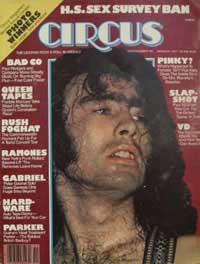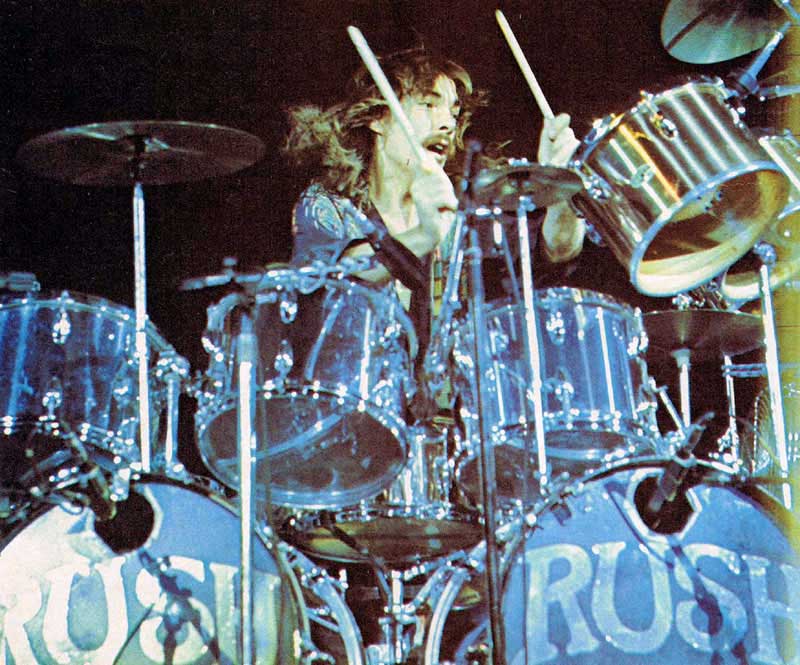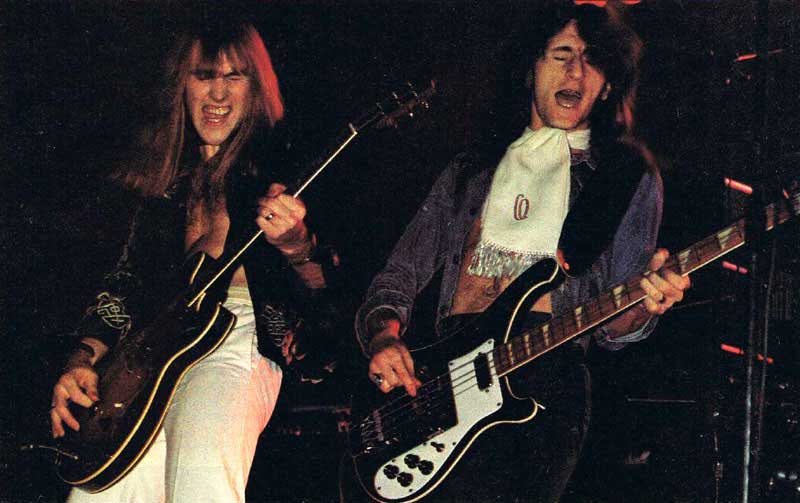Rush & Foghat: Two Top Live acts team Up For One Night Of Electrified Pleasure
By Richard Hogan, Circus, March 17, 1977

What band plays "Fly By Night," tours incessantly through a country once foreign to it, has twelve long-play sides of chart-riding rock to its credit, and holds sway over legions of midland devotees? If you answer Rush and Foghat you'll be right twice. It had to be in the cards: the northeastern booking pairing these two joy machines for three nights of flashing floodlights and chorded concussion.
Showtime. No intergroup fan rivalry hushes the strident notes which fly from the string of Sunn and Ampeg cabinets stretched across the performing space of Foghat and Rush as the bands cut loose with highlights from their respective Bearsville and Mercury albums. The show wends its way west, where both groups headline key cities. Foghat reaches the Coast first where, following warm-ups in Detroit and Chicago, two weeks recording go into a live LP.
"The live album is definitely on," spouts Foghat's skin-slogging Roger Earl between bites of an English muffin. "We're all excited. It's so important for a band, a live album," the ex-Londoner continues, "'cause it really shows all your power and energy ... how crazy you are on stage. It's just the four of you and nothing else.
"We've recorded live before, but we wanted to do the actual live album with the new lineup, which includes Craig MacGregor, that'd give a better flow and feel to the band. "It'll be the familiar numbers, but the whole dynamics of the songs have turned around. 'Slow Ride' is different and 'I Just Want to Make Love' has grown from four to eighteen minutes. "After we finish the tour this month, we'll take a week off from the road, get together and mix all the live stuff to hear what we've got." Roger pulls a special project out of his Foghat. 'We'll film some of the shows to use for television, with the sound and the playdates under our control. We're through working with amateur bastards. It's nice to work with people only when they're professional and up for it."

Professionalism is a hallmark of both bands and of the "other people" Foghat and Rush hire to work for them. Each group has a sound engineer who has traveled with the band for several years, toying with the computer digital delays and harmonizers that allow Roger's drums, for example, to continue sounding and vibrating even after he's left his riser. They enable Lonesome Dave Peverett to play a phase-shifted bass line along with his solo guitar on Foghat's "Boogie" encore. Or let Rush guitarist Alex Lifeson play a note that the crowd will hear in harmony with itself. The lighting men, too, are known as much for their permanence as for their dependability.
"'Herns,' who is also our road manager; has been with us since I joined," comments Rush's fleet-fingered drummer Neil Peart. "He flips the switches for our constantly developing light show. It's been two-and-a-half years now." It was Herns who thought up the characters By-Tor and the Snow Dog around which Neil wrote fanciful lyrics for two of Rush's myth-tinged tunes: Neil continues, "Everybody else in the crew has come along all the way."
Likewise Foghat's man-at-the-dials, Jimmy 0uteda, is practically family and it is he who orchestrates the visual stage wonders when this drollest of hard-rock outfits sets its red-and-silver-shod feet on the boards. The whirling planetarium effect that accompanies Foghat's madcap entrance to the stately strains of Elgar's "Pomp and Circumstance" ... the burst of smoke and red light when Rod Price rips into "It Hurts Me Too" on his solo guitar ... the green neon dangling like sn aurora above the funhouse stage ramp ... the lights which seem to change the color of Rod's satin suit from silver to blue, and bounce off the mirrors stitched into singer Lonesome Dave's shimmering costume lame' ... such magic is in Jimmy's domain.

Between gigs, Roger Earl checks his hotel laundry and reflects on how Foghat has tightened up its visuals and sound system over the past three years. "The main reason we didn't use those devices (harmonizers and digital delays) in person before (we used them on the records) was that we couldn't afford them. A DDL costs about four grand. But we've really had to add them haven't we? Every band that plays is trying through its gear to sound good, so the sound quality is as important as the visuals. If you don't maintain it at a high level, you re not keeping up. I mean, you don't want to go out on stage and say, 'We have to have three hours ... ' and be boring. It's all got to be energy and adrenalin. We like to hit the audience while the fever's there."
To augment performance frenzy, Rush as well as Foghat keep stretching its music-making capabilities with on-stage additions. "Geddy's just acquired a double-necked guitar, a beautiful machine," says Neil Peart. "And he's using synthesizer bass pedals when we play Lakeside Park, which again is a whole new sound for us."
"It's the very first double-necked Rickenbacker git-bass," Geddy explains. They made it specially for me in L.A. With its blue teardrop design, Geddy's space-bass, a customized Fender/Savannah, complements the high boots he dons at the end of the show. Alex Lifeson, the fashionplate of the trio, straps his new twin-neck Gibson around an embroidered green French velvet jacket made from a pattern given him by Gene Simmons of Kiss. "Alex is using two Echoplexes in conjunction," adds Neil; "One on a slow speed and one on a fast, so he can use them independently and, also, together to get a very good effect."
Neil has some surprises up his cossack sleeves, too. "I'm just now learning to play keyboard percussion, which involves the whole field of tubular and orchestra bells." Moving in a direction some of his favorite bands with progressive drummers ... Genesis, ELP and Ambrosia are going, Neil confides: "I've been practicing and working at them for the past few months. I'm hoping soon to acquire new drums with a whole set of keyboard percussion. Neil reveals how his kit helps him create such captivating tones during his solo: "I use sets of tube cowbells, melodic tom-toms and sets of chimes to get a different sound. " Played with his right drumstick twirling, Neil's percussion showcase Punctuates a performance which' now includes a film and slides to accompany the space-rock epic "2112."
"We don't want to stop at any particular plateau. We were faced with the choice of adding a band member or else getting really ambitious and doing it ourselves. We want more textures, new sounds. Constantly, new sounds and new textures have to be brought into our music to make it grow."
The four members of Foghat are no strangers to the flowering stage-gear syndrome either. "We've refined our set-up as we've gone along," comments Roger. "Mainly it's a fidelity thing." So as to hear exactly what the rest of Foghat is playing, Roger surrounds himself with adjustable monitors; rows of front and side monitors adorn the stage, and Foghat hauls its own ponderous P.A. to all dates.
"I remember when it was a van," Roger reminisces. "Now it's three fucking trucks. Still, we're giving everybody a job, aren't we? We've got eighteen bloody hotel rooms." By contrast, Rush tours with a crew of six. Regardless of the number of vehicles, both bands try for the same result: an optimum way to present what is the crux of their careers ... their music. Given the growing specialization within the realm of hard rock, Rush's sound may be three parts sword-and-sorcery to Foghat's two parts black cat bones and a hand me down mojo; but attitudes are strikingly alike. "The music still remains the priority," Neil Peart insists; "That's the way it should be."
"There's been gold hung in front of our noses," Roger Earl continues, "but money can't be the ulterior motive. If it is, you're not going to do it. Go and buy a bank if you want money! I didn't get into this to earn a living, I got into it 'cause I like to play music and I want it to be that way." The same seems to hold true for the rest of the band. "That's the common denominator of everything we do and every way we go. We work hard at keeping that."
Both bands will continue to visit places that have given them warm receptions before: Chicago, Cleveland, Detroit, Indianapolis, Erie and Cincinnati for both ... L.A., St. Louis and Salt Lake City for Foghat ... Texas, the northwest and native Ontario for Rush.
"We're leaning toward the twenty and thirty thousand seat arenas," smiles Roger. In an unguarded moment he removes his shades. His patented flyaway scarf is absent from his neck, and in his hand is a stiff drink instead of a dancing drumstick.
"On the road you can't plan your life so as to have something each morning you know will be pleasant to wake up to. It's just another day. It's really only that eighty minutes on stage that saves it ... that pulls us through the rest. You walk out on the platform and you get the big rush, all the way down and all the way up again. I know it makes me grin!"